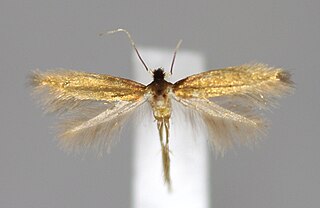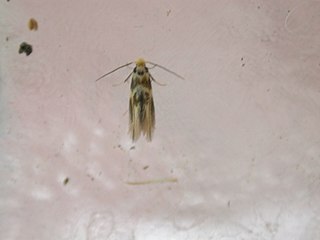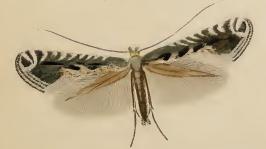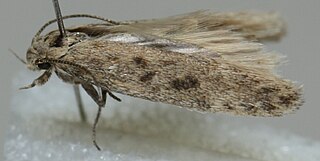
Incurvaria pectinea is a moth of the family Incurvariidae. It is found in Europe.

Prays fraxinella, also known as the ash bud moth, is a moth of the family Plutellidae found in Europe. The larvae are leaf miners, feeding on the leaves and buds of ash trees.

Simyra albovenosa, the reed dagger, is a moth of the family Noctuidae. It is found in most of Europe, then Turkey, Iran, Transcaucasus and into the east Palearctic.

Bucculatrix frangutella is a moth of the family Bucculatricidae. It was described by Johann August Ephraim Goeze in 1783. It is found in Europe.

Bucculatrix cidarella is a moth of the family Bucculatricidae. It is found in most of Europe, Kazakhstan and Japan (Honshu). It was described in 1839 by Philipp Christoph Zeller.

Hellinsia tephradactyla is a moth of the family Pterophoridae found in most of Europe. It was first described by the German taxonomist Jacob Hübner in 1813.

Bucculatrix cristatella is a species of moth of the family Bucculatricidae. It is found in most of Europe. It was described in 1839 by Philipp Christoph Zeller.

Bucculatrix nigricomella is a species of moth of the family Bucculatricidae. It was first described in 1839 by Philipp Christoph Zeller. It is found in most of Europe.

Bucculatrix thoracella, the lime bent-wing, is species of moth in the family Bucculatricidae, and was first described in 1794 by Carl Peter Thunberg as Tinea thoracella. It is found throughout Europe with exception of Ireland and the Balkan Peninsula, and in Japan, where it occurs on the islands of Hokkaido and Honshu.

Phyllonorycter salictella is a moth of the family Gracillariidae. It is known from all of Europe, east to Russia and Japan.

Parornix torquillella is a moth of the family Gracillariidae found in Europe. The larvae mine the leaves of Prunus species, such as blackthorn. It was described by the German entomologist Philipp Christoph Zeller in 1850, from specimens found in Florence, Leghorn and Pisa.

Calybites phasianipennella is a moth of the family Gracillariidae. It is known from all of Europe and most of Asia.

Apodia bifractella is a moth of the family Gelechiidae. It is found in most of Europe, as well as Turkey, the Caucasus and North Africa.

Bucculatrix ulmella is a moth of the family Bucculatricidae. It is found in most of Europe, except the Iberian Peninsula, Slovenia and Bulgaria. It was first described in 1848 by Philipp Christoph Zeller.

Bucculatrix bechsteinella is a moth of the family Bucculatricidae. It was described by Johann Matthäus Bechstein and Georg Ludwig Scharfenberg in 1805. It is found in most of Europe, except Greece and Bulgaria.

Bucculatrix demaryella is a moth of the family Bucculatricidae. The species was first described by Philogène Auguste Joseph Duponchel in 1840. It is found in most of Europe, Russia and Japan.

Paraswammerdamia albicapitella is a moth of the family Yponomeutidae. It is found in most of Europe, except the western part of the Balkan Peninsula, Ukraine, Lithuania and Latvia. It was recently reported from Canada.

Scrobipalpa atriplicella, the goosefoot groundling moth, is a moth of the family Gelechiidae. It is found from most of Europe throughout Asia to Kamchatka and Japan. It is an introduced species in North America.

Scrobipalpa obsoletella, the summer groundling, is a moth of the family Gelechiidae. It is found in most of Europe, Turkey, the Caucasus, from Iran to Asian Russia (Transbaikal) and Mongolia. It has also been recorded from New Zealand, South Africa and North America, where it is probably an introduced species. The habitat consists of coastal salt marshes and sandy beaches.

Phalonidia affinitana, the large saltmarsh conch or large saltmarsh bell, is a species of moth of the family Tortricidae, the subfamily Tortricinae, and the tribe Cochylini. It is found in China, Japan, Korea, Russia and most of Europe. Its habitat consists of salt marshes.




















